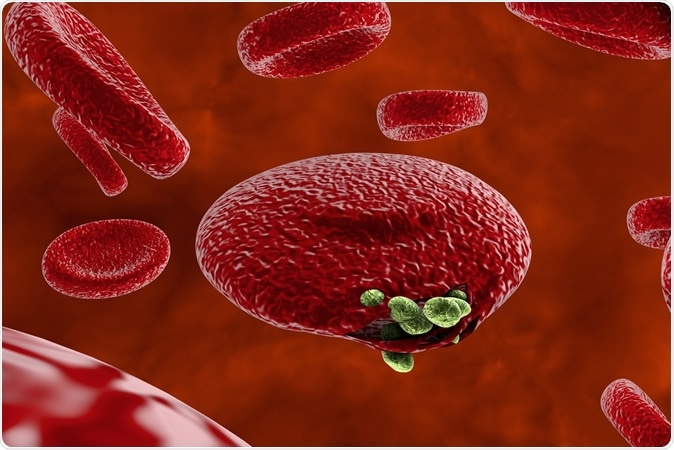A new study describing the outcome of a clinical trial of two malaria treatment protocols involving the use of triple therapies based on artemisinin reports their high efficacy and low adverse effects.

Release of malaria parasites from red blood cell. Image Credit: Kateryna Kon / Shutterstock
The study
The trial is the first of its kind, covering about 1,100 people in 8 countries, aged 2-64 years, all suffering from uncomplicated falciparum malaria (either alone or mixed with other species of plasmodium). The researchers assigned them to receive the current first-line treatment consisting of two drugs, or either of two triple artemisinin-based combination therapies – (TACTs).
The first TACT comprises dihydroartemisinin-piperaquine plus mefloquine and the second, artemether-lumefantrine plus amodiaquine. The regimen was assigned to each patient based on the drugs used as first-line ACTs (artemisinin-based combination therapies) in his or her country. If the first-line ACT had changed during the study period, because of the emergence of resistance, the researchers also changed the comparison treatment around.
Of the whole group, 17% received dihydroartemisinin-piperaquine, 25% the first TACT, 7% artesunate-mefloquine, 26% artemether-lumefantrine, and 26% the second TACT.
The treatment was evaluated for effectiveness based on the complete absence of malaria parasites and clinical features after 42 days of follow-up, which was recorded as a complete cure. Adverse effects were also documented at this time.
Why TACTs?
The rationale behind the testing of TACTs is the combination of ACTs with another drug to prolong the antimalarial activity of the combination in the blood.
ACTs have long been the backbone of global antimalarial efforts. Nonetheless, resistance to artemisinin as well as its partners is rapidly gaining ground in southeast Asia.
Many scientists have tried to address such resistance, typically to the action of multiple drugs targeting malaria, by changing around the treatment guidelines. The downside is that there is a smaller number of drugs to treat this condition, while the development of new antimalarials is currently on the backburner. As a result, there is a crying need for better and newer antimalarials in the places that struggle with antimalarial resistance. These include sub-Saharan Africa and India.
The TACT just adds to the ability of the ACT to act against the parasite while helping the combination to protect each other. Not only could this be an effective treatment for malaria, but it could also carry the possibility of staving off the emergence of drug resistance to antimalarial drugs. As researcher Chanaki Amaratung says, “Deployment of TACTs is expected to extend the useful life of the few effective available and affordable antimalarial drugs. Fortunately, to date, artemisinin resistance has not worsened in southeast Asia and has not spread to sub-Saharan Africa. To ensure we reduce resistance as much as possible, it is important that we avoid waiting for resistance to emerge and spread before changing malaria therapies.”
The findings
The researchers found that the first TACT was 98% effective compared with the first ACT at 48% in three countries in Southeast Asia. However, in Myanmar, both TACT and ACT had similar efficacy.
When the second TACT and the second ACT were compared, in five countries, similar efficacy was achieved.
At three sites in Cambodia, the drugs were changed due to national policy changes, and comparable results were obtained with the revised ACT and TACT.
Vomiting within an hour of treatment was more common with the first TACT than with the first ACT, but overall, both TACTs were safe and well-tolerated. Both ACTs and TACTs had the same incidence of serious adverse effects.
Implications
Expert commentator Philip Rosenthal says the results indicate the use of TACTs instead of ACTs in places where the latter is unacceptably low in efficacy. The use of mefloquine in the TACT could prevent piperaquine resistance from emerging. According to Rosenthal, “If safety and tolerability remain acceptable in follow-up studies, the use of optimally dosed and formulated TACTs to treat P falciparum malaria might soon be appropriate in regions with artemisinin resistance.”
However, in places where artemisinin is still effective, which coincides with the hotspots for falciparum malaria, the usefulness of TACTs is still uncertain, he says. In his view, “In any event, TACTs should be seen as a stopgap; novel combination therapies to treat malaria are greatly needed.”
Researcher Arjen Dondorp explains, “With the increasing failure of conventional ACTs, the use of TACTs might soon become essential for the treatment of malaria in the Greater Mekong subregion in southeast Asia. This region is aiming for accelerated malaria elimination before the growing drug resistance renders Plasmodium falciparum malaria close to untreatable. The TACTs we studied here could prevent a resurgence of malaria that often accompanies spreading antimalarial drug resistance.”
Journal reference:
Van der Plujim, R. W., Tripura, R., Hoglund, R. M., et al. Triple artemisinin-based combination therapies versus artemisinin-based combination therapies for uncomplicated Plasmodium falciparum malaria: a multicentre, open-label, randomised clinical trial. The Lancet. Published online first March 11, 2020. https://www.thelancet.com/journals/lancet/article/PIIS0140-6736(20)30552-3/fulltext